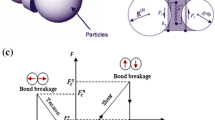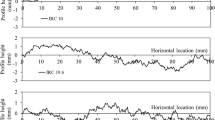Abstract
This paper reports the results from a comprehensive numerical study on the effects of micro-parameters of the smooth joint model (SJM) on the macro-properties and the associated failure modes of synthetic rock masses (SRM) under the uniaxial compression condition using the three-dimensional discrete element method. Important mechanical and geometrical micro-parameters of SJM that show significant effects on the macro-properties and the failure modes of SRM are identified. Strong coupling effects are found to exist between various important micro-parameters so that the eventual sample failure is a result of the complicated interaction among these micro-parameters. A limitation of the current stress-dilatancy relation accounting for the joint roughness effect is also identified. The numerical results presented in this paper are valuable for the evaluation of the current model capability in simulating and predicting the shear failure behavior of rock masses, and the further improvement of the model for its full application to the study of the behavior of real rock masses at the laboratory or field scales.

















Similar content being viewed by others
References
Bieniawski, Z.T.: Determining rock mass deformability: experience from case histories. Int. J. Rock Mech. Min. Sci. Abstr. 15(5), 237–247 (1978)
Barton, N.R., Lien, R., Lunde, J.: Engineering classification of rock masses for the design of tunnel support. Rock Mech. Rock Eng. 6(4), 189–236 (1974)
Barton, N.R.: Some new Q-value correlations to assist in site characterization and tunnel design. Int. J. Rock Mech. Min. Sci. 39(2), 185–216 (2002)
Hoek, E., Brown, E.T.: Practical estimates of rock mass strength. Int. J. Rock Mech. Min. Sci. 34(8), 1165–1186 (1997)
Palmstrom, A.: Characterizing rock masses by the RMi for use in practical rock engineering: part 1: the development of the rock mass index (RMi). Tunn. Undergr. Space Technol. 11(2), 175–188 (1996)
Palmstrom, A.: Characterizing rock masses by the RMi for use in practical rock engineering: part 2: some practical applications of the rock mass index (RMi). Tunn. Undergr. Space Technol. 11(3), 287–303 (1996)
Huang, T.H., Chang, C.S., Chao, C.Y.: Experimental and mathematical modeling of fracture of rock joint with regular asperities. Eng. Fract. Mech. 69, 1977–1996 (2002)
Barton, N., Bandis, S.: Effects of block size on the shear behavior of jointed rock. In: Proceedings of the 23rd US Rock Mechanics Symposium, pp 739–760. University of California, Berkeley (1982)
Sonmez, H., Ulusay, R., Gokceoglu, C.: A practical procedure for the back analysis of slope failures in closely jointed rock mass. Int. J. Rock Mech. Min. Sci. 35(2), 219–233 (1998)
Kulatilake, P.H.S.W., Malama, B., Wang, J.: Physical and particle flow modeling of jointed rock block behavior under uniaxial loading. Int. J. Rock Mech. Min. Sci. 38(5), 641–657 (2001)
Kulatilake, P.H.S.W., Wang, S., Stephansson, O.: Effect of finite size joints on the deformability of jointed rock in three dimensions. Int. J. Rock Mech. Min. Sci. Abstr. 30(5), 479–501 (1993)
Min, K.B., Jing, L.: Stress dependent mechanical properties and bounds of Poisson’s ratio for fractured rock masses investigated by a DFN–DEM technique. Int. J. Rock Mech. Min. Sci. 41(1), 390–395 (2004)
Min, K.B.: Fractured rock masses as equivalent continua—a numerical study, Ph.D. thesis, Royal Inst Tech (KTH), Stockholm, Sweden (2004)
Itasca Consulting Group Inc.: 3DEC—Three Dimensional Distinct Element Code, Version 4.1, Minneapolis, MN (2008)
Itasca Consulting Group Inc.: UDEC—Universal Distinct Element Code, Version 4.0, Minneapolis, MN (2009)
Eberhardt, E., Stead, D., Coggan, J.S.: Numerical analysis of initiation and progressive failure in natural rock slopes—the 1991 Randa rockslide. Int. J. Rock Mech. Min. Sci. 41(1), 69–87 (2004)
Ivars, D.M.: Bonded particle model for jointed rock mass. Ph.D. thesis, Stockholm, Sweden: Royal Institute of Technology (KTH), TRITA-LWR PHD 1058 (2010)
Potyondy, D.O., Cundall, P.A.: A bonded-particle model for rock. Int. J. Rock Mech. Min. Sci. 41, 1329–1364 (2004)
Itasca Consulting Group Inc.: PFC\(^{{\rm 2D}}\)—Particle Flow Code in 2 Dimensions, Version 4.0. Minneapolis, MN (2008)
Itasca Consulting Group Inc.: PFC\(^{{\rm 3D}}\)—Particle Flow Code in 3 Dimensions, Version 4.0. Minneapolis, MN (2008)
Cho, N., Martin, C.D., Sego, D.C.: A clumped particle model for rock. Int. J. Rock Mech. Min. Sci. 44, 997–1010 (2007)
Park, E.S., Martin, C.D., Christiansson, R.: Simulation of the mechanical behavior of discontinuous rock masses using a bonded-particle model. In: Proceeding of 6\(^{th}\) North Amer Rock Mech Symp, paper ARMA 04-480 (2004)
Ivars, D.M., Potyondy, D.O., Pierce, M., Cundall, P.A.: The smooth-joint contact model. In: Proceedings of WCCM8-ECCOMAS, Venice (2008)
Ivars, D.M., Pierce, M., Darcel, C., Reyes-Montes, J., Potyondy, D.O., Young, R.P., Cundall, P.A.: The synthetic rock mass approach for jointed rock mass modeling. Int. J. Rock Mech. Min. Sci. 48, 219–244 (2011)
Deisman, N., Ivars, D.M., Pierce, M.: PFC2D smooth joint contact model numerical experiments. GeoEdmonton’08. Edmonton, Canada (2008)
Ivars, D.M., Pierce, M., DeGagne, D., Darcel, C.: Anisotropy and scale dependency of jointed rock-mass strength—a synthetic rock mass study. In: Proceedings of the 1st International FLAC/DEM Aymposium on Numerical Modeling, pp. 231–239 (2008)
Chiu, C.C., Wang, T.T., Weng, M.C., Huang, T.H.: Modeling the anisotropic behavior of jointed rock mass using a modified smooth-joint model. Int. J. Rock Mech. Min. Sci. 62, 14–24 (2013)
Bahaaddini, M., Sharrock, G., Hebblewhite, B.K.: Numerical investigation of the effect of joint geometrical parameters on the mechanical properties of a non-persistent jointed rock mass under uniaxial compression. Comput. Geotech. 49, 206–225 (2013)
Esmaieli, K., Hadjigeorgiou, J., Grenon, M.: Estimating geometrical and mechanical REV based on synthetic rock mass models at Brunswick Mine. Int. J. Rock Mech. Min. Sci. 47(6), 915–926 (2010)
Manouchehrian, A., Sharifzadeh, M., Marji, M.F., Gholamnejad, J.: A bonded particle model for analysis of the flaw orientation effect on crack propagation mechanism in brittle materials under compression. Arch. Civ. Mech. Eng. 14(1), 40–52 (2014)
Zhang, C., Chen, X., Hou, J., Chu, W.: Study of mechanical behavior of deep-buried marble at Jinping II hydropower station. Chin. J. Rock Mech. Eng. 10, 1999–2009 (2010). (in Chinese)
Hazzard, J.F., Young, R.P., Maxwell, S.C.: Micromechanical modeling of cracking and failure in brittle rocks. J. Geophys. Res. 105(B7), 16683–16697 (2000)
Wang, J., Dove, J.E., Gutierrez, M.S.: Anisotropy-based failure criterion for an interphase system. J. Geotech. Geoenviron. Eng. ASCE 133(5), 599–608 (2007)
Huang, H.: Discrete element modeling of tool-rock interaction. Ph.D. thesis, University of Minnesota, USA (1999)
Kaitkay, P.V.: Modeling of rock cutting using distinct element methods. Ph.D. thesis, Kansas State University (2002)
Lei, S.: Distinct element modeling of laser assisted machining ofsilicon nitride ceramics. In: Reddy, R.G. (eds.) NSF Des. Serv. Manuf. Grantees Res. Conf. Proc. pp. 1270–1281 (2003)
Yang, B.D., Lei, S.: Distinct element simulation of conventional and laser assisted machining of silicon nitride ceramics: material removal mechanism. In: Kovacevic, R. (eds.) NSF Des. Serv. Manuf. Grantees Res. Conf. Proc. (2004)
Potyondy, D.O., Cundall, P.A.: A bonded-particle model for rock. Inter. J. Rock Mech. Min. Sci. 41(8), 1329–1364 (2004)
Yang, B., Jiao, Y., Lei, S.: A study on the effects of microparameters on macroproperties for specimens created by bonded particles. Eng. Comput. 23(6), 607–631 (2006)
Dorby, R., Ng, T.T.: Discrete modeling of stress–strain behavior of granular media at small and large strains. Eng. Comput. 9, 129–143 (1992)
Huang, H.Y.: Discrete element modeling of tool-rock interaction. Ph.D. thesis, University of Minnesota, Minneapolis, MN, USA (1999)
Yang, B., Jiao, Y., Lei, S.: A study on the effects of microproperties for specimens created by bonded particles. Eng. Comput. 23, 607–631 (2006)
Wang, J., Dove, J.E., Gutierrez, M.S.: Discrete–continuum analysis of shear banding in the direct shear test. Géotechnique 57(6), 513–526 (2007)
Wang, J., Gutierrez, M.S., Dove, J.E.: Numerical studies of shear banding in interface shear tests using a new strain calculation method. Int. J. Numer. Anal. Methods Geomech. 31, 1349–1366 (2007)
Wang, J., Gutierrez, M.: Discrete element simulations of direct shear specimen scale effects. Géotechnique 60(5), 395–409 (2010)
Gutierrez, M.S., Wang, J.: Non-coaxial version of Rowe’s stress-dilatancy relation. Granul. Matter 11(2), 129–137 (2009)
Zhou, B., Huang, R.Q., Wang, H.B., Wang, J.: DEM investigation of particle anti-rotation effects on the micro-mechanical response of granular materials. Granul. Matter 15(3), 315–326 (2013)
Wang, J., Yan, H.B.: DEM analysis of energy dissipation in crushable soils. Soils Found. 52(4), 644–657 (2012)
Wang, J., Yan, H.: On the role of particle breakage in the shear failure behavior of granular soils by DEM. Int. J. Numer. Anal. Methods Geomech. 37(8), 832–854 (2013)
Wang, J., Dove, J.E., Gutierrez, M.S.: Determining particulate-solid interphase strength using shear-induced anisotropy. Granul. Matter 9(3–4), 231–240 (2007)
Acknowledgments
This research was supported by the General Research Fund No. CityU 122813 from the Research Grant Council of the Hong Kong SAR and the Research Grant No. 51379180 from the National Science Foundation of China.
Author information
Authors and Affiliations
Corresponding author
Rights and permissions
About this article
Cite this article
Huang, D., Wang, J. & Liu, S. A comprehensive study on the smooth joint model in DEM simulation of jointed rock masses. Granular Matter 17, 775–791 (2015). https://doi.org/10.1007/s10035-015-0594-9
Received:
Published:
Issue Date:
DOI: https://doi.org/10.1007/s10035-015-0594-9




